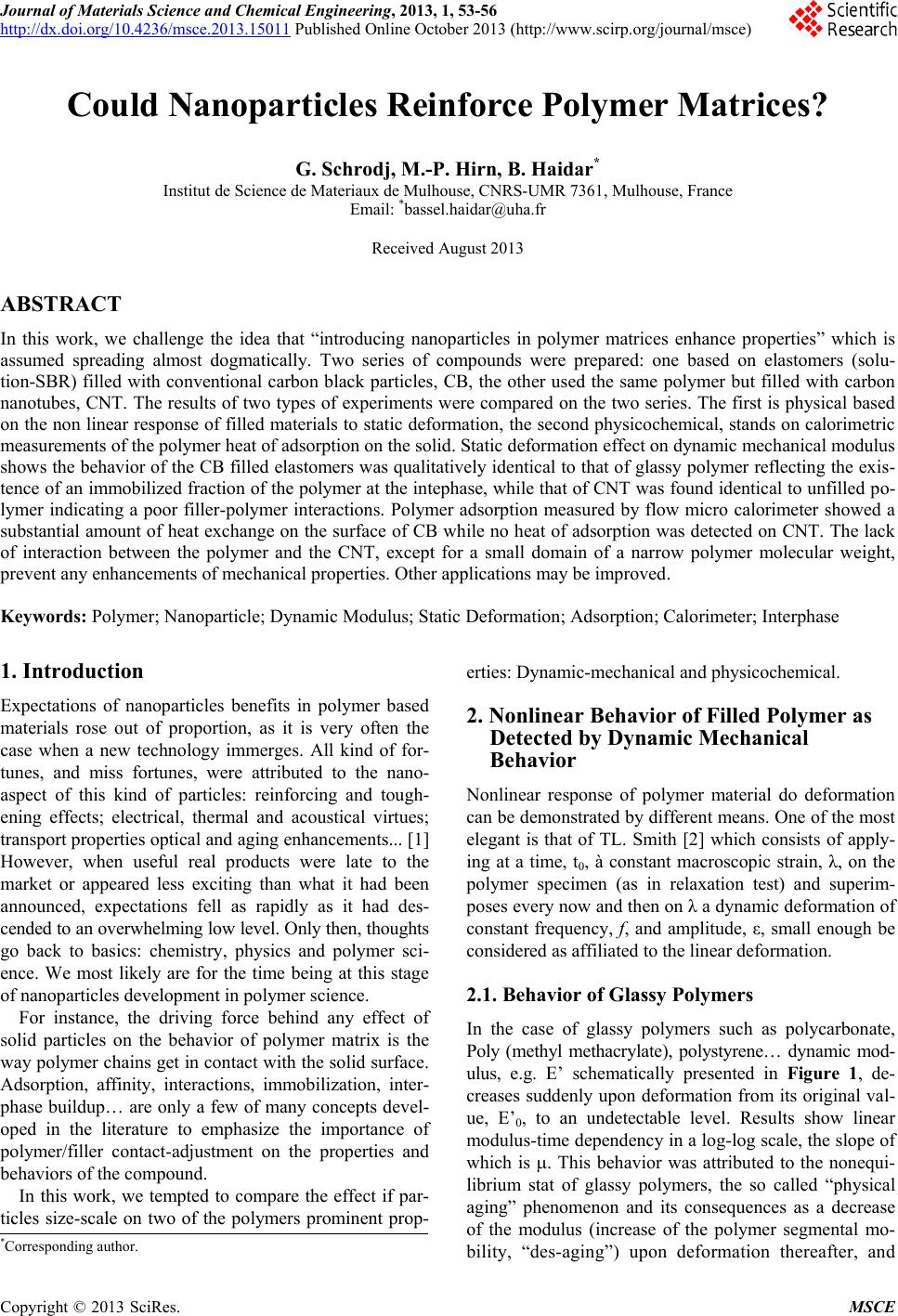
Journal of Materials Science and Chemical Engineering, 2013, 1, 53-56
http://dx.doi.org/10.4236/msce.2013.15011 Published Online October 2013 (http://www.scirp.org/journal/msce)
Copyright © 2013 SciRes. MSCE
Could Nanoparticles Reinforce Polymer Matrices?
G. Schrodj, M.-P. Hirn, B. Haidar*
Institut de Science de Materiaux de Mulhouse, CNRS-UMR 7361, Mulhouse, France
Email: *bassel.haidar@uha.fr
Received August 2013
ABSTRACT
In this work, we challenge the idea that “introducing nanoparticles in polymer matrices enhance properties” which is
assumed spreading almost dogmatically. Two series of compounds were prepared: one based on elastomers (solu-
tion-SBR) filled with conventional carbon black particles, CB, the other used the same polymer but filled with carbon
nanotubes, CNT. The results of two types of experiments were compared on the two series. The first is physical based
on the non linear response of filled materials to static deformation, th e second physicochemical, stands on calorimetric
measurements of the polymer heat of adsorption on the solid. Static deformation effect on dynamic mechanical modulus
shows the behavior of the CB filled elas tomers was qualitatively identical to that of glassy polymer reflecting the exi s-
tence of an immobilized fraction of the polymer at the intephase, while that of CNT was found identical to unfilled p o-
lymer indicating a poor filler-polymer interactions. Polymer adsorption measured by flow micro calorimeter showed a
substantial amount of heat exchange on the surface of CB while no heat of adsorption was detected on CNT. The lack
of interaction between the polymer and the CNT, except for a small domain of a narrow polymer molecular weight,
prevent any enhancements of mechanical properties. Other applications may be improved.
Keywords: Polymer; Nanoparticle; Dynamic Modulus; S tatic Deformation; Adsorption; Calorimeter; Interphase
1. Introduction
Expectations of nanoparticles benefits in polymer based
materials rose out of proportion, as it is very often the
case when a new technology immerges. All kind of for-
tunes, and miss fortunes, were attributed to the nano-
aspect of this kind of particles: reinforcing and tough-
ening effects; electrical, thermal and acoustical virtues;
transport properties optical and aging enhancements... [1]
However, when useful real products were late to the
market or appeared less exciting than what it had been
announced, expectations fell as rapidly as it had des-
cended to an overwhelming low level. Only then, thoughts
go back to basics: chemistry, physics and polymer sci-
ence. We most likely are for the time being at this stage
of nanoparticles development in polymer science.
For instance, the driving force behind any effect of
solid particles on the behavior of polymer matrix is the
way polymer chains get in contact with the solid surface.
Adsorption, affinity, interactions, immobilization, inter-
phase buildup… are only a few of many concepts devel-
oped in the literature to emphasize the importance of
polymer/filler contact-adjustment on the properties and
behaviors of the compound.
In this work, we tempted to compare the effect if par-
ticles size-scale on two of the polymers prominent prop-
erties: Dynamic-mechanical and physicochemical.
2. Nonlinear Behavior of Filled Polymer as
Detected by Dynamic Mechanical
Behavior
Nonlinear response of polymer material do deformation
can be demonstrated by different means. One of the most
elegant is that of TL. Smith [2] which consists of apply-
ing at a time, t0, à constant macroscopic strain, λ, on the
polymer specimen (as in relaxation test) and superim-
poses every now and th en on λ a dynamic deformation of
constant frequency, f, and amplitude, ε, small enough be
considered as affiliated to the linear defor ma tion.
2.1. Behavior of Glassy Polymers
In the case of glassy polymers such as polycarbonate,
Poly (methyl methacrylate), polystyrene… dynamic mod-
ulus, e.g. E’ schematically presented in Fig u r e 1, de-
creases suddenly upon deformation from its original val-
ue, E’0, to an undetectable level. Results show linear
modulus-time dependency in a log-log scale, the slope of
which is µ. This behavior was attributed to the nonequi-
librium stat of glassy polymers, the so called “physical
aging” phenomenon and its consequences as a decrease
of the modulus (increase of the polymer segmental mo-
bility, “des-aging”) upon deformation thereafter, and
*Corresponding a uthor.